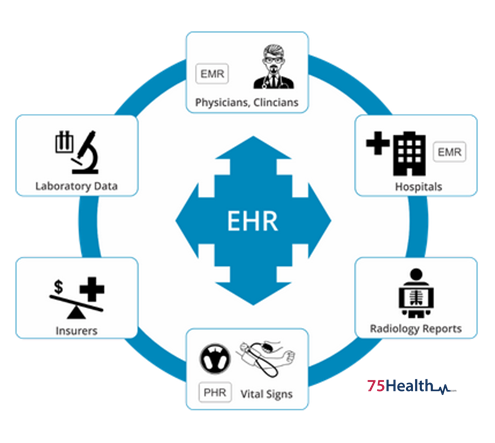
What is an electronic health record (EHR)?
An electronic health record (EHR) is a digital version of a patient’s paper chart. EHRs are real-time, patient-centered records that make information available instantly and securely to authorized users. While an EHR does contain the medical and treatment histories of patients, an EHR system is built to go beyond standard clinical data collected in a provider’s office and can be inclusive of a broader view of a patient’s care. EHRs are a vital part of health IT and can:
- Contain a patient’s medical history, diagnoses, medications, treatment plans, immunization dates, allergies, radiology images, and laboratory and test results
- Allow access to evidence-based tools that providers can use to make decisions about a patient’s care
- Automate and streamline provider workflow
One of the key features of an EHR is that health information can be created and managed by authorized providers in a digital format capable of being shared with other providers across more than one health care organization. EHRs are built to share information with other health care providers and organizations – such as laboratories, specialists, medical imaging facilities, pharmacies, emergency facilities, and school and workplace clinics – so they contain information from all clinicians involved in a patient’s care.
What are the advantages and disadvantages of electronic health records?
According to a study in the Journal Of Risk Management and Health Policy, Electronic health record (EHR) systems have the potential to transform the health care system from a mostly paper-based industry to one that utilizes clinical and other pieces of information to assist providers in delivering a higher quality of care to their patients. Examples of the numerous benefits and advantages of electronic medical records in hospitals and other healthcare facilities include:
Convenience. Medical and office staff no longer have to waste time sorting through cumbersome paper records. Users can access electronic health records quickly and efficiently with just a few strokes on a keyboard. Most electronic health record systems make it possible to create templates. Those templates direct caregivers to enter specific notes or records for every patient, making it possible to accurately document required information on a patient-to-patient basis. Even though different visits might require different documentation, the EHR makes it possible to stop data loss by offering reminders of what needs to be done.
Saves Time and Space. When a patient portal is introduced with an EHR system, it can be set up so that patients can input their own data directly into their records. Instead of spending 20 minutes filling out paperwork at the doctor’s office before a visit, they can enter their data directly into their file days, if not weeks, before their scheduled visit. It saves them time and it saves time on the administrative work by the medical provider. Electronic health records also eliminate the need to store documents in bulky file cabinets, which frees up more space in the office for medical supplies and equipment, and other essentials.
Improved Quality of Care. Computerized notes are often easier to read than a physician’s handwriting. With an EHR system, doctors can immediately place orders for imaging or laboratory work. This reduces the chance of an error occurring because the handwriting of the doctor is difficult to decipher. This benefit extends to the placement of a prescription order as well. An electronic order can be sent directly to the pharmacy of choice for a patient. By the time a person gets to the pharmacy, their order could potentially be ready.
Patient Access. Many EHR systems include a patient portal that allows patients to view their medical history and information whenever they wish. This also allows every patient to reference a treatment plan or understand how their doctor sees their current state of health at any time. Whether they want to check a prescription that they are on, or they want to provide their medical history to a specialist, patients have both a right and a need to access their records. As such, they will often request them from their physician, but finding, copying, and providing them can take time. An electronic health record system often provides an online patients’ portal that they can use to access their medical history and information wherever and whenever they wish.
Easier to read and organize than physical notes. Physician’s notes may be a comfortable and familiar way of taking down records, but they can prove unreliable over time. For one, digital records are much easier to read and more legible. What’s more, because the electronic health record stores them all in a standardized format, it is much easier to skim through directly for the information more relevant to your queries at the time.
Financial Incentives. Installing a certified EHR can help you fulfill the Meaningful Use requirements for Medicaid and Medicare, making you eligible for various incentives from the federal government.
What Are the Disadvantages of Electronic Health Records?
There are also several disadvantages of electronic medical records, such as:
Potential Privacy and Cyber-security Issues. As with just about every computer network these days, EHR systems are vulnerable to hacking, which means sensitive patient data could fall into the wrong hands. Most certified EHR systems have security measures in place, but the staff of a physician’s business must be trained in basic digital security to ensure they do not leave their stations vulnerable to unauthorized access. Having your patient’s data fall into the wrong hands is not acceptable.
Inaccurate Information. Because of the instantaneous nature of electronic health records, they must be updated immediately after each patient visit — or whenever there is a change to the information. The failure to do so could mean other healthcare providers will rely on inaccurate data when determining appropriate treatment protocols.
Frightening Patients Needlessly. Because an electronic health record system enables patients to access their medical data, it can create a situation where they misinterpret a file entry. This can cause undue alarm, or even panic.
Malpractice Liability Concerns. There are several potential liability issues associated with EHR implementation. For example, medical data could get lost or destroyed during the transition from a paper-based to a computerized EHR system, which could lead to treatment errors. Since doctors have greater access to medical data via EHR, they can be held responsible if they do not access all the information at their disposal.
Require frequent updates. Since other healthcare professionals partnered with you, such as personal trainers and pharmacists, may be using the same electronic health record system as you, it is essential that you keep patient records updated after every appointment or consultation. Otherwise, they may check the system later to find inaccurate data without your knowledge, leading to inappropriate approaches to treatment. READ: What Does DSP Mean In Healthcare






